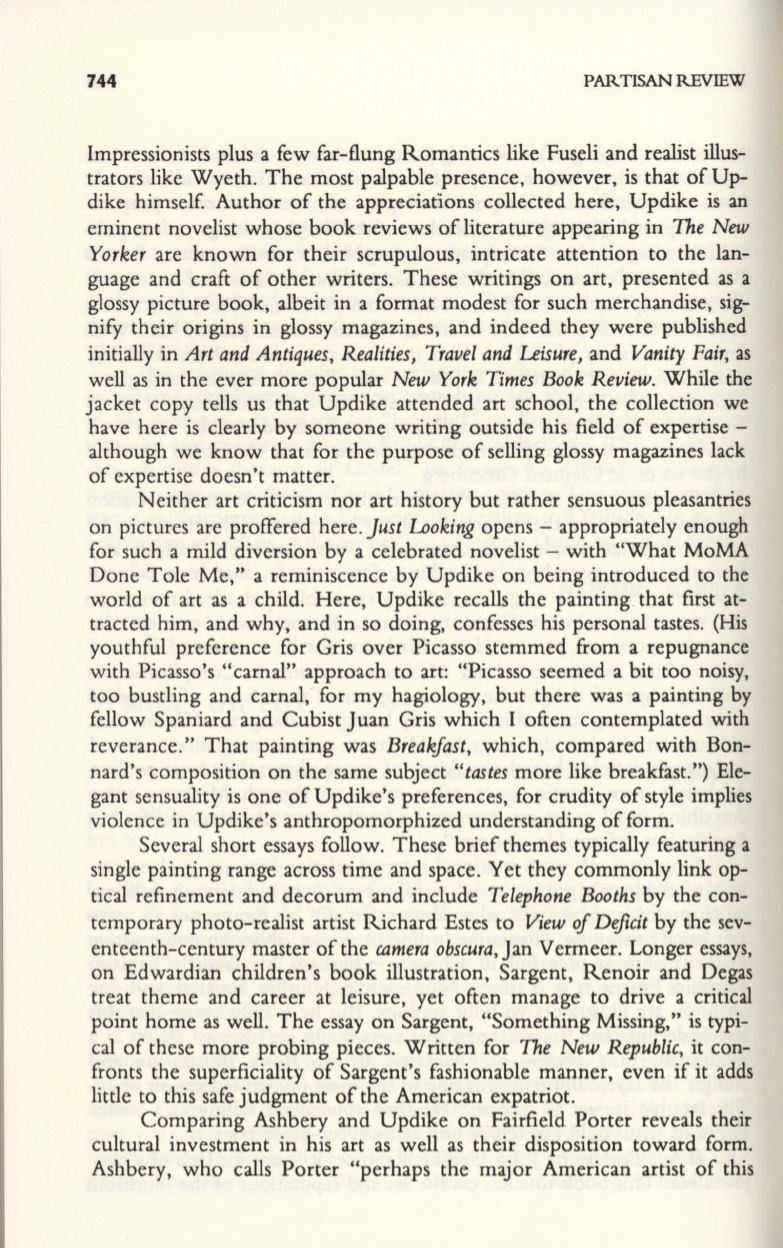
744
PARTISAN REVIEW
Impressionists plus a few far-flung Romantics like Fuseli and realist illus–
trators like Wyeth. The most palpable presence, however, is that of Up–
dike himsel£ Author of the appreciations collected here, Updike is an
eminent novelist whose book reviews of literature appearing in The
New
Yorker
are known for their scrupulous, intricate attention to the lan–
guage and craft of other writers. These writings on art, presented as a
glossy picture book, albeit in a format modest for such merchandise, sig–
nify their origins in glossy magazines, and indeed they were published
initially in
Art and Antiques, Realities, Travel and Leisure,
and
Vanity Fair,
as
well as in the ever more popular
New York Times Book Review.
While the
jacket copy tells us that Updike attended art school, the collection we
have here is clearly by someone writing outside his field of expertise -
although we know that for the purpose of selling glossy magazines lack
of expertise doesn't matter.
Neither art criticism nor art history but rather sensuous pleasantries
on pictures are proffered here.
Just Looking
opens - appropriately enough
for such a mild diversion by a celebrated novelist - with "What MoMA
Done Tole Me," a reminiscence by Updike on being introduced to the
world of art as a child. Here, Updike recalls the painting that first at–
tracted him, and why, and in so doing, confesses his personal tastes. (His
youthful preference for Gris over Picasso stemmed from a repugnance
with Picasso's "carnal" approach to art: "Picasso seemed a bit too noisy,
too bustling and carnal, for my hagiology, but there was a painting by
fellow Spaniard and Cubist Juan Gris which I often contemplated with
reverance." That painting was
Breakfast,
which, compared with Bon–
nard's composition on the same subject
"tastes
more like breakfast.") Ele–
gant sensuality is one of Updike'S preferences, for crudity of style implies
violence in Updike's anthropomorphized understanding of form.
Several short essays follow. These brief themes typically featuring a
single painting range across time and space. Yet they commonly link op–
tical refinement and decorum and include
Telephone Booths
by the con–
temporary photo-realist artist Richard Estes to
View
of
Defidt
by the sev–
enteenth-century master of the
camera obscura,
Jan Vermeer. Longer essays,
on Edwardian children's book illustration, Sargent, Renoir and Degas
treat theme and career at leisure, yet often manage to drive a critical
point home as well. The essay on Sargent, "Something Missing," is typi–
cal of these more probing pieces. Written for The
New Republic,
it con–
fronts the superficiality of Sargent's fashionable manner, even if it adds
little to this safe judgment of the American expatriot.
Comparing Ashbery and Updike on Fairfield Porter reveals their
cultural investment in his art as well as their disposition toward form.
Ashbery, who calls Porter "perhaps the major American artist of this


